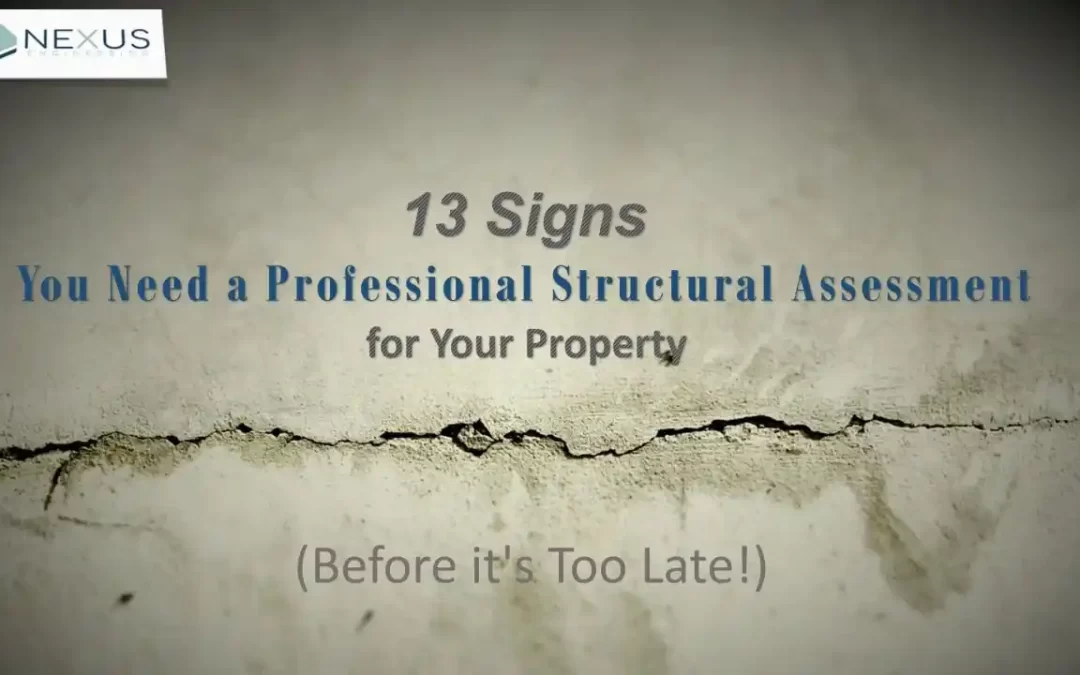The structural integrity of your property is crucial for safety and long-term value. Over time, buildings can develop signs of wear and damage that may require a professional structural assessment.
Ignoring these warning signs can lead to costly repairs or, worse, endanger the lives of those inside.
In this article, we’ll highlight 13 key signs you need a professional structural assessment before it’s too late.
Category 1: Visible Structural Damage
Sometimes, the most obvious signs of structural problems are right in front of us. These signs are the easiest to spot. Pay close attention to these visible cues, as they can indicate significant underlying issues.
1. Cracks in Walls, Ceilings, or Foundations
Cracks can appear in different areas of your home. One of the common types of cracks is hairline cracks in walls, ceilings, or foundations.
Hairline cracks may be due to natural settling, while larger, deeper cracks—especially horizontal ones—could indicate serious foundation issues.
These cracks weaken the overall structure and may lead to further deterioration if left unattended.
Watch out for cracks that are widening especially around windows and doors, have a step-like pattern, or are accompanied by other signs of damage.
These cracks could be a result of foundation settlement, soil erosion, or structural stress.
You May Also Read: Ensuring the Structural Integrity of Your Commercial Fitout
2. Uneven or Sagging Floors
Floors that slope, sag, or feel uneven when you walk across them often point to foundation or structural issues. This can be caused by water damage, poor construction, or foundation settling.
If you find yourself tripping over uneven floors, it might be time for a closer look. By acting proactively, you can restore structural stability and avoid costly repairs.
3. Visible Sagging Roof
A sagging roof isn’t just an aesthetic issue—it can be a sign that the internal structural supports are failing. This can be caused by factors such as poor construction, water damage, excessive weight, or foundation issues.
A sagging roof can compromise the structural integrity of your property and increase the risk of leaks and other damage.
4. Bowing or Leaning Walls
Bowing or leaning walls are a major red flag, often caused by foundation shifts or external pressure, such as soil movement. Leaning of walls is a common issue with older properties.
These walls may eventually collapse if the underlying issue isn’t addressed, posing a severe safety hazard to anyone inside the property.
5. Chimney Separation from the House
A chimney pulling away from the house is another structural instability that you need to keep an eye on. This separation can be caused by foundation settlement, wind damage, or other factors.
A separating chimney not only affects stability but also compromises the overall safety and integrity of your home, requiring immediate assessment.
If you notice a gap between your chimney and the house, it’s important to have it inspected by a professional structural engineer.
6. Gaps Between Floors and Walls
Gaps that appear between floors and walls can be a sign of foundation problems.
These gaps might indicate that the foundation is settling or shifting, causing the structure to become uneven.
If you notice these gaps, it’s a good idea to have a structural engineer assess the situation.
7. Doors and Windows Not Closing Properly
If your doors or windows are sticking, not aligning properly, or refusing to close, it’s often due to foundation movement.
Foundation movement can cause misaligned frames, leading to doors and windows that stick, rub, or won’t close completely. This can also affect the energy efficiency of your home.
You May Also Read: From Concept to Completion: How a Structural Engineer Collaborates with Your Vision
8. Water Damage or Stains on Ceilings/Walls
Persistent water damage or stains on your ceilings or walls can be a precursor to more serious structural issues. These leaks can lead to rot, mold, and weakening of structural components over time.
Leaks can weaken the structural elements of your home, leading to rot, mold, and potential collapse.
Even minor water intrusion can gradually erode the integrity of your property if not addressed early.
If you notice water damage, it’s important to address the underlying cause promptly.
Category 3: Hidden or Subtle Indicators
Some signs of structural damage are less obvious but equally concerning. Keep an eye out for these hidden or subtle indicators that might reveal more severe problems beneath the surface:
9. Persistent or Worsening Mold Growth
Mold in addition to causing hygiene problems, also weakens structural components. Mold growth can be a sign of underlying moisture problems, which can lead to structural damage.
If you notice persistent or worsening mold growth, it’s important to address the root cause. This could involve repairing leaks, improving ventilation, or addressing foundation issues.
Inspect your home for potential mold growth and if needed consult a professional before the issue gets out of hands.
You May Also Read: Streamlining Your Project Timeline: How Effective Project Management Can Benefit Your Business
10. Foundation Settling or Sinking
Foundation settling is a natural process, but if the foundation sinks unevenly, it can lead to significant structural instability.
Uneven settling can cause cracks in walls, floors, and ceilings, as well as doors and windows that won’t close properly. If you suspect foundation issues, it’s essential to have a professional inspection.
11. Exposed or Rusted Steel Beams
Steel beams serve as the backbone of a building structure, but when exposed or rusting, their strength is compromised.
Exposed or rusted steel beams are a serious concern, as rust can weaken the structural integrity of your property. Therefore, rusted beams should be replaced or repaired immediately.
12. Creaking or Popping Noises
Unusual creaking or popping noises can be a sign of structural stress or shifting.
These noises might indicate that the building is settling, or that there are underlying issues with the foundation or support beams.
If you hear these noises, it’s a good idea to have a professional structural inspection.
13. Basement Flooding or Water Intrusion
Recurring basement flooding or water intrusion can compromise the health of your foundation.
Moisture can lead to rot, mold, and erosion, weakening the structural integrity of your property.
If flooding is a recurring issue, a professional structural assessment is essential.
The Risks of Ignoring Structural Issues
Ignoring structural issues can have serious consequences, both for your property and your personal safety. Here are some of the risks associated with neglecting these problems:
- Property Value Loss: Structural issues can significantly reduce the value of your property. Potential buyers may be hesitant to purchase a property with known structural problems, leading to a lower selling price.
- Safety Hazards: Structural damage can create safety hazards for you and your family. This includes the risk of collapse, fires, and injuries.
- Costly Repairs: Ignoring structural issues can lead to more extensive damage over time, making repairs much more expensive. In some cases, the cost of repairs may exceed the value of the property.
- Insurance Claims: Structural damage can affect your insurance coverage. If you fail to address underlying structural issues, your insurance company may deny claims related to subsequent damage.
By addressing structural problems promptly, you can protect your investment, ensure the safety of your property, and avoid costly repairs in the long run.
How to Schedule a Professional Structural Assessment with Nexus Engineering
Scheduling a structural assessment with Nexus Engineering is simple. Whether you’re concerned about visible damage or just want to ensure your building’s long-term health, Nexus Engineering is here to help.
Steps to Contact a Professional:
- Initial Inquiry: Contact Nexus Engineering through our website, phone, or email. We’ll set up a convenient time for a consultation based on your needs. Visit Contact Us page.
- Consultation and Inspection: Our team will conduct a thorough on-site inspection, looking for potential structural issues.
- Assessment Report: You’ll receive a detailed report outlining any issues, along with practical solutions.
What a Professional Structural Assessment Covers and Why It’s Essential:
Nexus Engineering’s structural assessment and inspection cover everything from visible cracks to hidden foundation issues, ensuring your property is safe and compliant with standards.
With a focus on reliability and safety, our expert structural engineers ensure that no fault is left unnoticed.
Whether you’re facing foundation cracks, wall cracks, sagging roofs, or water damage, our tailored engineering solutions can help you resolve any issue.
You May Also Read: 7 Shocking Reasons Why You Need Seismic Design for Commercial Buildings in Australia
Conclusion
In conclusion, the safety and integrity of your property rely on timely identification of structural issues. Whether it’s visible cracks, uneven floors, or subtle signs like creaking noises, these indicators should never be ignored. Addressing them early can save you from costly repairs, preserve your property’s value, and, most importantly, ensure the safety of everyone inside.
Don’t wait until it’s too late—protect your investment and your family. Schedule a professional structural assessment with Nexus Engineering today and get peace of mind knowing your property is in expert hands.


Recent Comments